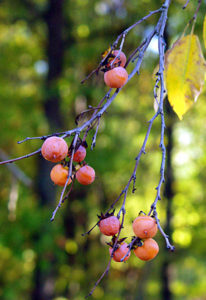Photo & Story by Joseph F. Persinger
When autumn’s colors explode across the fields and forests of Jackson County, many families participate in a longstanding tradition — the gathering of native persimmons.
These odd little orange-colored fruits — astringent and puckery when not fully ripe — develop their more appealing sweet and spicy flavor after they fall to earth or with the help of the first frost.
 A “green” persimmon usually is light orange in color and is hard and shiny while the fully ripened fruit is dark orange or brownish red, often with a slightly purple, “bruised” appearance and dull, wrinkled skin.
A “green” persimmon usually is light orange in color and is hard and shiny while the fully ripened fruit is dark orange or brownish red, often with a slightly purple, “bruised” appearance and dull, wrinkled skin.
The native or “common” persimmon (Diospyros virginiana), also known as ‘simmon, possumwood, and Florida persimmon, is found from southern Connecticut to southern Florida and westward through central Pennsylvania, southern Ohio, southern Indiana, and central Illinois to southeast Iowa, and south through eastern Kansas and Oklahoma to the valley of the Colorado River in Texas.
Surprisingly, it does not grow in the main range of the Appalachian Mountains nor in much of the oak-hickory forest on the Allegheny Plateau. It is common in the south Atlantic and Gulf states and is often the first tree species to appear on abandoned cropland.
Persimmon trees may begin producing fruit at about 5 years old but are at their peak of production from 25 to 50 years of age. The slow-growing tree with its glossy leathery leaves is an attractive choice for landscaping, but it is not easily transplanted because of its extended taproot.
The fruit is eaten by many species of songbirds and by skunks, raccoons, opossums, gray and fox squirrels, white-tailed deer, wild turkeys, bobwhite quail, crows, rabbits, hogs, and cattle.
By far the most popular preparation for human consumption is persimmon pudding— usually topped with sweet, rich whipped cream. Another favorite is persimmon bread, served warm from the oven, and some folks use their excess persimmon crop to make a uniquely flavored spicy white wine.
To prepare persimmons for cooking, simply press the ripe fruit through a colander to remove the large, flat seeds. Prepared pulp is sometimes available at roadside markets and supermarkets. Area churches and other non-profit groups sometimes sell prepared persimmon pulp as a fundraiser.
MAMAW PERSINGER’S PERSIMMON PUDDING
2 cups persimmon pulp
1-1/2 cups sugar
1/2 cup butter, melted
1 cup milk
1 teaspoon cinnamon
2 teaspoons baking powder
1-1/2 cups flour (or enough to make stiff as cake batter)
Melt the butter in a 9 by 13 baking pan and swirl it around to coat the insides of the pan. Blend the other ingredients in a mixing bowl and add the melted butter. Pour the batter into the buttered pan and bake at 375° for about 30 minutes. The pudding is done when the sides start to pull away from the pan. Serve with whipped cream or caramel topping.
PERSIMMON COOKIES
1 cup persimmon pulp
1 cup sugar
1/2 cup butter
2 cups flour
1 cup chopped nuts
1 cup raisins
1 teaspoon soda
1/2 teaspoon cloves
dash of salt
1 egg
1/2 teaspoon cinnamon
1/2 teaspoon nutmeg
Dissolve soda in persimmon pulp. Cream sugar and butter, add egg and persimmon pulp, spices, and flour. Dust nuts and raisins in some of the flour before adding them to batter. Drop batter from a spoon onto a greased cookie sheet. Bake about 10 minutes at 350°. Makes about four dozen cookies.
PERSIMMON BREAD
2 cups sugar
4 eggs
1 cup persimmon pulp
1 teaspoon soda
1 teaspoon vanilla
1 teaspoon cinnamon
1 cup vegetable oil
1-1/2 teaspoons salt
2/3 cup water
3 cups flour
Mix ingredients and divide among three loaf pans. Bake at 350° for about one hour.